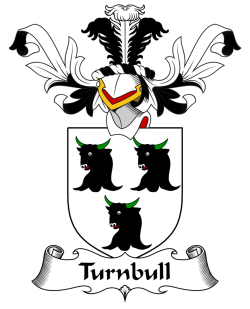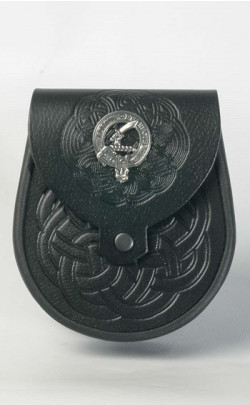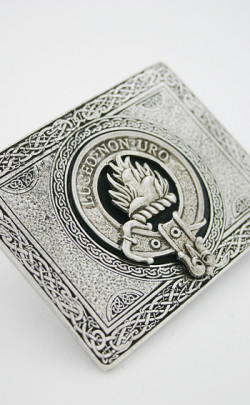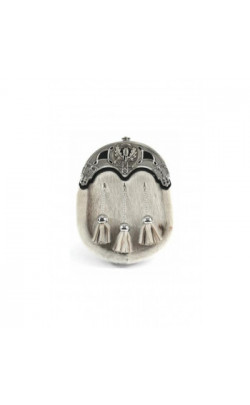
Clan Turnbull
I SAVED THE KING
Scottish History
of Clan Turnbull
Saving the king
A name that boasts a legendary origin rooted in Scotland’s turbulent past, ‘Turnbull’ and its numerous spelling variants has been present on British shores since at least the late eleventh century and in Ireland since at least the seventeenth century.
The accepted wisdom is that it derives from the French tumbald, or the Old English trumbald – both meaning ‘strong and bold’ – and first arrived in the wake of the Norman Conquest of 1066.
A revolt by Anglo-Norman nobles against William, Duke of Normandy in 1070 saw some settling in Scotland, while others including the original Anglo-Norman family of Bruce, for example, were granted lands in Scotland by David I during his reign from 1124 to 1153.
It is not known when those who would later bear the proud name of Turnbull first settled in Scotland, nor is it known what their original name was.
What is known with certainty is that they were firstly known in Scotland as ‘de Roule’ or ‘de Rule’, taking the name from the Rule Water, in the Scottish Borders, and where they had settled.
According to legend, it was a William de Rule who first adopted the Turnbull name.
This was in 1315, a year after a Scottish army commanded by the great warrior King Robert the Bruce inflicted a stunning defeat on an English army at the battle of Bannockburn.
William de Rule, according to the chronicler Hector Boece in his early sixteenth century History of Scotland, had been hunting with Bruce and Sir James Douglas near Callander, Stirlingshire, when the king was charged by a frenzied white bull.
De Rule, said to have been of massive bulk and fearless, saved the king by seizing the beast by the horns, twisting its neck and killing it.
As reward for this, he was given a grant of lands near Philiphaugh, in the Selkirk area of the Borders and given the name of ‘Turnebull’ – meaning ‘turn ye (the) bull.’
This is why, according to legend, the Turnbull motto is I saved the king and crest the head of a bull.
Casting some doubt on the veracity of the legend, however – although Sir William de Rule undoubtedly existed – is that a Robertus de Turnbulyes appears in the historical record 20 years before de Rule’s alleged heroic exploit with the bull and subsequent ‘creation’ of the Turnbull name.
Robertus de Turnbulyes name appears in the infamous Ragman Roll of 1296 – an invaluable source for the presence of particular names in Scotland at this period in the nation’s history.
Scotland had been thrown into crisis in 1285 with the death of Alexander II and the death four years later of his successor, the Maid of Norway, who died while en route to Scotland to take up the crown.
John Balliol was enthroned at Scone as King of Scots in 1292 – but fatefully for the nation the ambitious Edward I of England was invited to arbitrate in the bitter dispute over the succession to the throne, and the hapless Balliol was Edward’s chosen man.
The Scots rose in revolt against the imperialist designs of the English king in July of 1296 but, living up to his reputation of ‘Hammer of the Scots’, he brought the entire nation under his subjugation little less than a month later, garrisoning strategic locations throughout the country.
To reinforce his domination of the nation, 1,500 earls, bishops, burgesses and other landowners were required to sign a humiliating treaty of fealty, known as the Ragman Roll, because of the number of ribbons that dangled from the seals of the reluctant signatories.
The presence of Robertus de Turnbulyes’ signature indicates that he was considered a man of some substance and social standing.
A possible explanation for the discrepancy between the existence of a ‘Turnbull’ well before William de Rule is alleged to have adopted the name, is that the ‘bull’ element may actually refer to what was the popular sport of bull running – a dangerous pastime in which those who became known as ‘Turnbull’ may well have excelled.
Meanwhile the bold Sir William de Rule/ Turnbull enters the historical record again in 1333 in relation to his exploits at the battle of Halidon Hill.
Robert the Bruce had died in 1329 and was succeeded by the five-year-old David II.
Eager to take advantage of a dispute among the Scottish nobles over the young king’s succession, England’s ambitious Edward III gave his support to the rival John Balliol, descendant of the John Balliol who had been enthroned as King of Scots in 1292, confident he could use him as a mere puppet for his own imperialist aims.
A mighty English force invaded Scotland in August of 1332, defeating the Scots in battle at Dupplin Moor, near Perth.
Balliol was enthroned as King of Scots at Scone the following month and, as Edward had plotted, swore fealty to him.
Nationalist passions were aroused, however, and Andrew Murray, who had been appointed Guardian of Scotland, raised the banner of revolt against the puppet Scots king and sent him fleeing across the border to his English master, Edward.
But in May of 1333 Edward returned with another army, laid siege to Berwick Castle, and met the Scots in battle at Halidon Hill, to the northwest of Berwick, on July 19.
Murray had already been captured and the new Guardian was Archibald, Lord of Douglas, who arranged his forces in three tightly packed groups of spearmen known as schiltrons, and a division of 1,200 knights.
They proved no match, however, for the deadly skill of the English archers and the knights who had taken better strategic advantage of the terrain.
The English victory was so complete that while Douglas, the earls of Ross, Sutherland and Carrick, 500 knights, seventy barons, and hundreds of Scots foot soldiers were slain, the English were reported to have lost only fourteen men.
Before the battle proper, and as the chosen ‘champion’ of the Scottish army, Sir William de Rule/Turnbull, accompanied by his ferocious black mastiff, had approached the English lines and challenged their champion, the Norfolk knight Sir Robert Benhale to single combat.
Accepting the challenge, Benhale killed the Scots champion and his dog and, as an added humiliation, cut off Sir William’s head and sword arm and carried the head back to his lines as a trophy.
Despite Sir William’s grisly end, the Turnbulls flourished – holding in addition to the lands of Philiphaugh the lands of Minto and Hundleshope.
Among their several castles and fortifications scattered throughout their territory of the Borders was the rectangular tower in present day Roxburghshire colourfully known as Fatlips Castle.
The fortification acquired its unusual name through the Turnbull male custom of greeting all female visitors with a fulsome and lingering kiss on the lips.
Acquired by the Border clan, the Elliots, in 1705, it was restored in the mid-eighteenth century and remained in use until the 1960s.
Having fallen into a state of disrepair, a major work of restoration through the Landmark Trust is expected to be completed by 2013.
Meanwhile the Turnbull’s Philiphaugh estates remained in the family for 300 years, with the Murrays acquiring them through marriage.
The last of the Turnbull Chiefs died in 1572, but there is an active worldwide Turnbull Clan Association – whose proud members visited their ancestral homeland in 2009.
Moss troopers
Nearly 60 years before the death of their last Chief, Turnbulls were in the ranks of the Scottish army at the disastrous battle of Flodden in September of 1513.
This was where an estimated 5,000 Scots including James IV, an archbishop, two bishops, eleven earls, fifteen barons and 300 knights were killed.
The battle, remembered in the haunting lament The Flow’rs o’ the Forest (The Flowers of the Forest), describing how the cream of Scottish chivalry and manhood were wiped out, was one that should never have been fought in the first place.
The Scottish monarch had embarked on the venture after Queen Anne of France, under the terms of the Auld Alliance between Scotland and her nation, appealed to him to ‘break a lance’ on her behalf and act as her chosen knight.
But the gift of 15,000 French francs may also have acted as an added incentive to the monarch’s misplaced sense of chivalry.
Crossing the border into England at the head of a 25,000-strong army, James engaged a 20,000-strong force commanded by the Earl of Surrey.
Despite their numerical superiority and bravery, however, the Scots proved no match for the skilled English artillery and superior military tactics of Surrey.
When not engaged in battling English armies, bearers of the Turnbull name were still to be found engaged in warfare.
This was as one of the lawless Border families who were frequently to be found ‘reiving’, or raiding, not only their neighbours’ livestock, but also that of their neighbours across the border.
The word ‘bereaved’, for example, indicating to have suffered loss, derives from the original ‘reived’, meaning to have suffered loss of property.
A constant thorn in the flesh of both the English and Scottish authorities was the cross-border raiding and pillaging carried out by well-mounted and heavily armed men, the contingent from the Scottish side of the border known and feared as ‘moss troopers.’
In an attempt to bring order to what was known as the wild ‘debateable land’ on both sides of the border, Alexander II of Scotland had in 1237 signed the Treaty of York, which for the first time established the Scottish border with England as a line running from the Solway to the Tweed. On either side of the border there were three ‘marches’ or areas of administration, the West, East and Middle Marches, and a warden governed these.
Complaints from either side of the border were dealt with on Truce Days, when the wardens of the different marches would act as arbitrators.
There was also a law known as the Hot Trod, that granted anyone who had their livestock stolen the right to pursue the thieves and recover their property.
In the Scottish borderlands, the Homes and Swintons dominated the East March, while the Armstrongs, Maxwells, Johnstones and Grahams were the rulers of the West March.
The Turnbulls, along with others who included the Douglases, Gilchrists, Rutherfords and Taits, held sway in the Middle March.
One particularly notorious bearer of the Turnbull name was John “Out with the Sword” Turnbull, who held the Border lands of Minto.
Acquiring his nickname because of his explosive temper and readiness to do battle with anyone who dared cross his path, he was taken prisoner while on a cross-border raid in 1399 and imprisoned in the Tower of London for four years.
His martial temperament far from cooled, he found service with England’s enemy, France, and was killed fighting in the French ranks at the battle of Cravat in 1424.
Nearly ninety years later, in 1510, the Turnbulls were considered so unruly that 200 of their number were hunted down and arrested on the orders of James IV.
Forced to humiliatingly stand before the king wearing only linen shirts and halters around their necks, some were later hanged while others were imprisoned.
It was following the Union of the Crowns in 1603 that James I (James VI of Scotland) attempted to crush the Border mayhem once and for all.
The very term ‘Borders’ was abolished and renamed ‘the Middle Shires’, while scores of particularly unruly families were forcibly uprooted and either conscripted into military service or banished to Ireland.
Other, more law-abiding, families found themselves in Ireland through the early seventeenth century policy of ‘Plantation’ – the settling of loyal subjects on land previously held by what were deemed to be ‘rebellious’ native Irish.
Descendants of many of these Scots-Irish, including bearers of the Turnbull name, later found new lives for themselves in foreign parts, particularly North America, Australia and New Zealand, and this is where many of the name are to be found in large numbers today.
Back to the battlefield, Major Gordon Turnbull gained fame during the battle of Waterloo in 1815 by leading the 2nd Scots Greys in a counter-attack against the French cavalry of Nogue’s Brigade.
Despite being outnumbered by two to one and in what became known as the ‘Scotland Forever’ charge, Turnbull’s cavalry broke and destroyed the brigade.
In the American Revolutionary War of 1775 to 1783, George Turnbull was a Loyalist lieutenant colonel.
Born in 1729 at Blackadder Mains, Lanarkshire and later emigrating from Scotland to what was then the British colony of America, Turnbull as a loyal British subject not only raised but also commanded the New York Volunteers, leading them at the battle of Rocky Mount, South Carolina, in 1780; he died in 1810.
During the First World War, James Youll Turnbull, born in Glasgow in 1883, was a posthumous recipient of the Victoria Cross (VC), the highest award for valour in the face of enemy action for British and Commonwealth forces.
He had been a sergeant in the 17th Battalion (Glasgow Commercials), Highland Light Infantry, when during the battle of the Somme in July of 1916 at Leipzig Salient he single-handedly manned a machine-gun for about 24 hours against a full German regiment.
He was killed the following day leading a grenade attack on an enemy position.
The future Second World leader Winston Churchill wrote of him at the time: “The Germans were said, after seeing the body of Turnbull in his uniform kilt, to call him and all Scots ‘The Devils in Dress’ and ‘Ladies from Hell.’ ”
Away from the battlefield and back to the Turnbull homeland of Scotland, William Turnbull was responsible for the foundation in the fifteenth century of the centre of academic excellence now known as the University of Glasgow.
His date of birth is not recorded, but he is known to have studied at the University of St Andrews in 1419 and later at the Catholic University of Leuven, Belgium.
Obtaining a doctorate in canon law in 1439 from the University of Pavia, Italy, he returned to Scotland during the reign of James II and served from 1440 to 1448 as Keeper of the Privy Seal, having also served from 1441 to 1442 as Royal Secretary.
Appointed Bishop of Glasgow in 1448, and with the encouragement of James II, he successfully petitioned Pope Nicholas V for a Papal Bull that in 1451 authorised a university for Glasgow.
With the university then housed in Glasgow Cathedral, Turnbull served as its first chancellor until his death in 1454.
Turnbull Hall, the Catholic Chaplaincy at Turnbull’s alma mater of the University of St Andrews, is named in his honour as are Turnbull High School, East Dunbartonshire and Turnbull High school in Bishopbriggs, on the outskirts of Glasgow.
Bearers of the name have also achieved distinction in the world of politics and diplomacy.
Born in 1718, Andrew Turnbull was the Scottish doctor who served as British Consul at Smyrna, while Charles Turnbull, born in 1935 in St Thomas, U.S. Virgin Islands, served from 1999 to 2007 as their 27th Governor.
Created a life peer as Baron Turnbull in 2005, Andrew Turnbull is the former senior British civil servant born in 1945 in Enfield, London.
The head of Her Majesty’s Civil Service and Cabinet Secretary between 2002 and 2005, it was during this time that he was tasked by then Prime Minister Tony Blair to oversee a major reorganisation of the Civil Service.
Previous to this, he had served from 1988 to 1992 as Principal Private Secretary to the Prime Minister and, from 1998 to 2002, as Permanent Secretary to the Treasury.
In Australian politics, Malcolm Turnbull, born in Sydney in 1954 and a relation through his mother to the American actress Angela Lansbury, is the politician who served as Leader of the Opposition and Parliamentary Leader of the Liberal Party in the House of Representatives from September 2008 to September 2009.
Also chairman from 1993 to 2000 of the Australian Republican Movement, government posts he has held include Minister for Environment and Water Resources.
He is the husband of the former politician Lucy Turnbull, born Lucinda Mary Hughes in 1958.
A daughter of the former Australian Attorney-General Tom Hughes, she served between 2003 and 2004 as the first female Lord Mayor of Sydney.
A leading businesswoman, she was appointed an Officer of the Order of Australia in 2011 for service to the community through a range of philanthropic contributions and also her support for a number of social welfare, educational and other organisations.
Family History Mini Book
We hope you enjoyed reading this excerpt from this mini book on the Scottish history of the Turnbull family.
You can buy the full book for only79 Clan Turnbull
Tartan Products
The Crests
of Clan Turnbull







































































